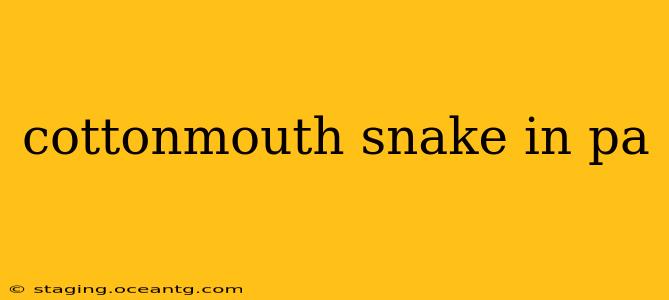Pennsylvania's diverse ecosystems support a variety of wildlife, but the venomous cottonmouth snake isn't one of them. While fear of encountering venomous snakes is understandable, it's crucial to understand the reality of cottonmouth distribution to avoid unnecessary anxiety. This comprehensive guide will address common concerns and misconceptions surrounding cottonmouths in Pennsylvania.
Are Cottonmouth Snakes Found in Pennsylvania?
No, cottonmouth snakes ( Agkistrodon piscivorus) are not found in Pennsylvania. Their natural range is limited to the southeastern United States, extending from Virginia south to Florida and west to Texas and Oklahoma. Pennsylvania's climate and habitat are unsuitable for this species.
What Snakes Are Found in Pennsylvania?
Pennsylvania boasts a variety of snake species, none of which are as venomous as the cottonmouth. These include:
- Northern Copperhead (Agkistrodon contortrix): A venomous pit viper, but generally less aggressive than cottonmouths. They are found in several parts of the state.
- Timber Rattlesnake (Crotalus horridus): Another venomous pit viper, known for its large size and distinctive rattle. Its presence is more localized within the state.
- Eastern Garter Snake (Thamnophis sirtalis): A non-venomous and common species throughout Pennsylvania.
- Northern Black Racer (Coluber constrictor): A non-venomous snake known for its speed and agility.
- Milk Snake (Lampropeltis triangulum): A non-venomous snake often mistaken for venomous species due to its coloration.
Understanding the differences between these snakes and learning to identify them is crucial for responsible co-existence. Many resources, including online field guides and herpetology websites, can assist in snake identification.
What are the Characteristics of a Cottonmouth?
Since many people mistake other snakes for cottonmouths, understanding their key features is important. Cottonmouths are characterized by:
- Heavy body: They are relatively stout and thick-bodied snakes.
- Dark, often black or brown coloration: They often have dark bands or cross-bands.
- Distinctive "cottonmouth": The white or pale interior of their mouth is visible when they feel threatened, hence the name.
- Heat-sensing pits: Like other pit vipers, they have heat-sensing pits between their eyes and nostrils.
How Can I Identify a Snake in Pennsylvania?
If you encounter a snake in Pennsylvania, do not attempt to handle it. Observe it from a safe distance and try to take a photograph if possible, focusing on characteristics like:
- Head shape: Is it triangular (venomous) or more rounded (usually non-venomous)?
- Body pattern: Note the colors, bands, and overall pattern.
- Size: How long is the snake?
- Location: Where was the snake sighted?
Use reliable resources to compare your observations with known Pennsylvania snake species.
What Should I Do If I Encounter a Snake?
If you encounter a snake in Pennsylvania, the best course of action is to:
- Remain calm: Do not approach or try to handle the snake.
- Give it space: Slowly and calmly move away from the area.
- Do not provoke: Avoid sudden movements that could startle the snake.
- Keep children and pets away: Ensure they maintain a safe distance.
If you are bitten by a snake, seek immediate medical attention.
This guide aims to clarify the absence of cottonmouths in Pennsylvania and provide helpful information on responsible snake identification and interaction within the state. Remember, most snakes are beneficial to the environment and should be treated with respect and caution.
